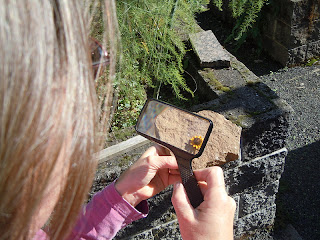Australian paleobotanist J. W. Schopf says he has found the world’s oldest fossils, the traces of single-celled organisms 3.4 billion years old. Other Australian scientists disagree. “No you di’n’t,” they pontificate. So there’s controversy. The second set of scientists has set up camp a few miles away and they think their fossils are the oldest. The whole issue is fraught. It’s hard to imagine picking up a rock and squinting at it hard enough to see a fossilized single cell that dated from the sulfurous primordial ooze. Maybe that’s what it is, but it could totally be petrified schmutz or retinal floaters or even something the guy only sees when he’s coming down off a toot. You’ve really got to want to see something like that to see it at all. I can’t even track my own point through a two-minute conversation, and these guys are finding stuff that used to be alive before dirt was invented.
That doesn’t mean it’s not so. Joe America tends to scoff at such reports, but Joe America can’t even find his own happiness without a remote control. Scientists are always drawing conclusions about things that can’t be seen. The Higgs Boson, for instance. A whole lot of people have put time and money into finding the Higgs Boson. No one has ever seen a Higgs Boson, but they figure it must be around somewhere because otherwise we wouldn’t have mass, and we know we have mass because we keep bumping into each other. The Higgs Boson, and the honorable quarks, are invisible things that are presumed to exist because their existence explains the observable forces, such as electromagnetism and gravitation. Scientists proposed their quarks and gave them splendid names, which always gets them extra points in my book: Up. Down. Charm. Strange. Truth. Beauty. (Truth and Beauty were later renamed Top and Bottom to better account for the forces of dominance and submission.)
 |
| Higgs Boson: artist’s rendition. |
So you can’t see a quark, or a boson. But you can prove their existence by flinging a bunch of shit at them really fast and seeing if they duck. That’s what they’re doing in the expensive particle accelerators. They’ve done well with the quarks, but they’re starting to wonder about the Higgs Boson. They’ve chased him into a corner and if he doesn’t show up they might have to conclude he doesn’t exist at all. Which would be dreadful. We’d be like the cartoon coyote that runs over a cliff and makes the mistake of looking down. We might just disappear. What if there is no Higgs Boson? What if we should have been looking for the Higgs Splorknit all along?
It may seem silly to make something up and then go looking for it, but it’s not uncommon in the sciences. Even in economics, people earnestly go on and on about the Trickle-Down Effect even though there’s no evidence for it at all. They have to propose its existence to explain why they have all the money. It’s easy to test the hypothesis. All you do is take the combined assets from millions of people engaged in honest labor for decades and invest it hard and fast until it smacks into something, scatters, and disappears, and thus you can infer the existence of extremely rich people, even though you’ll never see them. But we’re all scientists at heart. We see forces in the world that we don’t understand, so we postulate whatever we can to explain them: socialists, elitists, and evildoers. Or corporate overlords, fascists and fundamentalists. Take your pick and start looking, and you’ll see them everywhere.
I have an affinity for science, but it’s still tough to comprehend. When I’m in doubt, I throw in with whoever comes up with the best wordage, like the guy who named his quark Charm. I’m glad they finally found Up, Down, and Strange; maybe they’ll discover Pudge and Flappy some day. So I don’t really know which of the paleobotanists in Australia has come up with the oldest fossil, but I’m going with Dr. Schopf. He says he found his fossil stash in the Apex Chert of the Warrawoona Group. That’s good enough for me.

I'd probably have started with the Wilpena Pound, but Warrawoona may be closer.(maybe they'll find irrefutable evidence for paleolithic Drop Bears?)
Wow. I think I love you.
Have added you to my blog roll so I can check in on you more often. 🙂
Pearl
I thought I was the oldest fossil. Who knew?
"make something up and then go looking for it" Haha, silly indeed!
Hey Murr! This entertaining blog was packed with Nerdy goodness. BTW, I believe I may name my own personal quark "Slack". And yeah, what Pearl said. Indigo
I like chert. Poky on the outside, shiny on the inside, best observed after rubbing spit on it. Not too heavy to carry home in your pocket. Chert's good.
Indigo, shouldn't we all have a personal quark? Let's start naming them, people.
Pearl, back atcha. I love your writing.
Maybe we are the quarks. Just look in the mirror, scientists!
My personal favourite made-up thing is Heaven but I don't plan to go looking for it anytime soon.
Yes, we Aussies are a quarrelsome bunch, of course the BIG question down here is 'beer, full strength or light?'
Trickle down…isn't. Except in the most inefficient sense of the term, much as the ants in my kitchen might benefit from the few crumbs that may inadvertently trickle down to them during mealtime.
The thing is, the GOP has taken an obvious fact – we can't have a healthy economy without a healthy business sector – and extrapolated it to ludicrous conclusions. Just because businesses are thriving doesn't mean that workers will benefit much, even though non-thriving businesses will definitely make us all suffer. We need laws and regulations to make sure that thriving businesses don't hoard the profits to the detriment of the larger economy and societal well-being. We also need laws and regulations that ensure workers don't bottom out when business isn't thriving as usual.
But, see? That doesn't fit into a 3-word phrase (although I am darn well working on it). "Trickle Down" does. How about Trickle Down Lite? Trickle Down 2.0? Trickle Up? Trickle This?
Oh, well, I guess Occupy Wall Street works as well as any. If I were there, I'd be carrying a sign saying "Trickle Down THIS, Buddy" or "What about DOWN don't you understand?"
"you can infer the existence of extremely rich people, even though you'll never see them." Harrumph! I thought that was what "reality" tv was for! Silly me. Elaine
Best analogy of wealth I've ever read Brewster. Way to go. Throwing money at something invisible pretty well describes Wall Street altogether.
The sighting of this paleo-one-celled wonder puts me in mind of my botany professor who told of spotting a rare plant on a woodland hike. "If I hadn't believed it, I never would have seen it," he said. Maybe believing makes it so or at least seems to bring it into focus.
Didn't Wayne Dyer write a book with that very same title? "When you believe it, you will see it!" I think he did.
My quark is Ping. Can I have Pong, too? I can tell which is which by the frequency emitted when something hits them and they squark. You know, Ping pings higher than Pong pongs, in the aural analog of Up and Down. (The corollary is that I believe in very small sound waves, and I believe I have magnificent ears.)
Science and math (I believe both are very intertwined) go over my head so fast that I feel the concussion from their travel!!I know a young man who is brilliant and wants to be a theoretical particle physicist (a what?????) and when he talks science, my jaw drops and I begin to see spots before my eyes. Out of habit I will nod on occasion as if I understand. Eventually he will stop, stare at me, shake his head and then say something like, "To put it simply…" which really ends up confounding me at least half of the time. Like trying to mix oil and water, my brain and science or math do not gel!
There is evidence of quarks. Strange quark scat everywhere.
Trickle-down Effect? Not so much.
There's a lo5t of "trickle" coming out of the Rushpubliscum Party these days…
At the NW Physics Conference last weekend, the tables during coffeebreaks were abuzz with the nuances of Dark Matter. Finally one multi-degreed speaker began his presentation with: "Let's prove the existence of Dark Matter before we begin guessing its variation. Thank the astrophysics kahunas you're also one of the people doesn't put all their quarks in a boson.
Anything small than something to eat can't be trusted.
I agree with Mr. Charleston! Your skill at solidly tying quarks and Wall Street fiscal manipulations together is nothing short of brilliant, (and I work with really smart people for a living).
Your posts are a pleasure to read, I just wish they had a wider audience.
Thank you!
Gee, Jack, are any of the smart people you work with involved with the publishing industry?
Pearl, I was just thinking, "I love her blog." You extended it to "I love you," which is a too extreme for me.
Aww.
There IS SO Trickle Down Effect! The contempt has worked its way through the baffles and around the loopholes and has hit us right in our collective schnoz. We've been stunned for about three years, seeing little birdies flying around our noggins, but we're coming to at last. We see it all clear as a bell now; sumbody done sumbody wrong.
The argument over quarks can best be summed up as, "My quark is just like yours and yours isn't. So there."
Nancy,
you've made it to my funny quotes list, and that ain't too shabby. Next stop, Pulizer Prize.
Nance, the point about the Occupy protests is that they're not putting too fine a point on it; and it can't be said any better than you said it: sumbody done sumbody wrong.